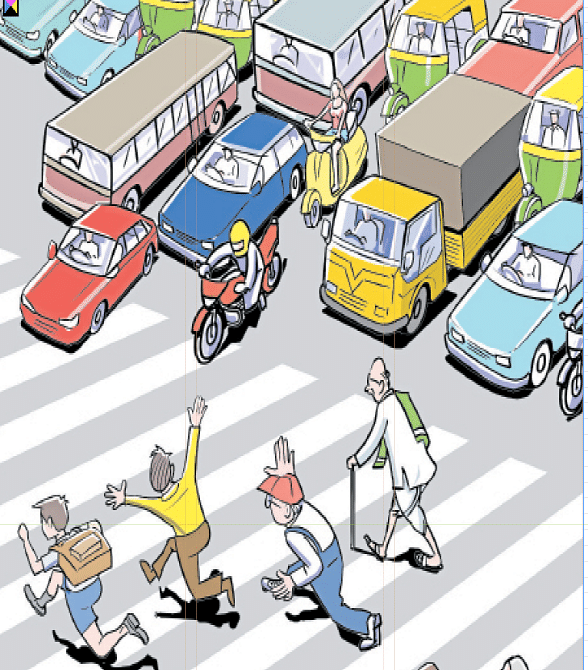The broken pavement challenged their resolve. Struggling, the old couple heaved a sigh of relief as the signal turned green. But the moment they stepped on the zebra crossing, they knew they were too slow. Three seconds later, the vehicular deluge had trapped them right in the middle...
The couple had just joined lakhs of pedestrians pushed aside by a vehicular onslaught that shows zero tolerance for walkability. Powered by a motorist-first approach, traffic intersections across the city now switch to pedestrian green only for a micro second. That’s like saying: We don’t care!
Twenty seconds
So, how long should the signal stay green for walkers to cross a road safely? At least 20 seconds, one way, says Sathya Sankaran, a seasoned mobility expert who had scientifically worked out the maths years ago.
Is this a realistic time frame, when intersections across Bengaluru have virtually reduced the pedestrian pause time to near zero? From Hudson Circle to Queen’s Circle, Indiranagar 100ft Road-CMH Road junction to Shoolay Circle, pedestrians scramble to cross, only to be dangerously caught in the middle, trapped.
Taking a motorist-first approach for years, the city’s mobility infrastructure is now clearly not in favour of the pedestrian, notes Sankaran. “Removal of pedestrian-crossing time should be made illegal. At many junctions, even signal lights have been taken away.”
IRC guidelines
The Indian Road Congress (IRC) has stipulated clear guidelines on pedestrian crossings. “Formal mid-block pedestrian crossings should be provided at regular intervals (i.e., at least every 200 m) to ensure that pedestrians have a safe place to cross,” says one guideline.
This is critical, Sankaran reminds. “You cannot expect people to walk 500m to a kilometre to get a pedestrian crossing.” The IRC goes further, “To ensure safety, formal crossings should be signalised or should be constructed as tabletop crossings with ramps for vehicles.”
Also recommended are raised crossings, so that vehicles are compelled to reduce their speed, thereby increasing safety. “Warning tiles should be laid wherever there is a pedestrian crossing.”
The Institute for Transportation and Development Policy (ITDP) highlights a preferred design, where the intersection is raised to the level of the footpath. The rationale: “Vehicles slow down when crossing over the ramp, and a material difference emphasises that they are entering a shared space.”
To further enhance pedestrian safety during crossing, it recommends ramps at all intersections that are not signalised. At signalised intersections, the IRC says the footpath should be ramped down to the level of the carriageway. The ramp should not be steeper than 1:10.
Traffic-calming measures
By design, stop the traffic for 60-90 seconds, suggests urban planner V Ravichander. He explains, “Let the pedestrians walk freely, even diagonally. Let vehicles wait, heavens won’t fall. In cities such as London, this works very well. Why not try this at the M G Road – Brigade Road junction, for instance?”
This, he says, can work well where the pedestrian movement is very high. “This can also be a good traffic-calming measure. For vehicles that speed from one junction but get stuck in the next, the 60-90 second wait will eventually not make any difference.”
Pedestrians should ‘own’ the road, he notes. “To me, the core problem is the mindset that ‘pedestrians don’t exist.’ Unless you bring them to the centrestage and let them reclaim the road, things will not change.”
Rising risks
Poor road geometry on most streches outside the few TenderSURE streets mean pedestrians are often stranded in the middle of a four-lane road. They run the risk of getting knocked down by speeding vehicles jumping signals without a thought. Is there a way to deal with this?
Beyond crossing time extensions, one way out is to build strong ‘refuge islands’ as ITDP mandates, citing IRC rules. “Refuge islands in a mid-block crossing are essential when pedestrians need to cross more than two lanes. The islands gives pedestrians time to rest and reorient themselves before crossing the rest of the street.”
Refuge islands
Refuge islands are mandated when the roads are too wide and if there are free left turns, explains Additional Director General of Police, Administration, M A Saleem, who had served as the city’s Additional Commissioner of Traffic for many years.
Most city road junctions, he recalls, had 15 seconds for pedestrians to cross. This was the rule, particularly at intersections where four roads meet.
Saleem also talks about hooters that were introduced at many junctions to alert motorists when the pedestrian walk signal was switched on. Today, the hooters have vanished from most intersections. Motorists are often seen approaching the junctions at high speeds and jumping signals, risking lives.
Unused facilities
But pedestrians too do not always use the facilities provided, notes Saleem. “Most of the skywalks and underpasses remain unused. On Nrupathunga Road, for instance, there are two underpasses. Both are hardly used,” he points out.
Poor use of the skywalks has been attributed to wrong location, faulty design, inability of senior citizens to climb up and a motorist-focussed mobility policy. Whatever the reason, pedestrian lives have been endangered by multiple factors.
Pedestrian deaths
The implications have been alarming. An independent analysis by The Footpath Initiative showed that pedestrians accounted for 2/3rd of the fatal accidents reported in Bengaluru in 2017. Of the 282 pedestrians who died, 186 cases were on the city’s arterial roads.
Further studies by the Initiative shows a continuing trend both in 2018 and 2019. “The majority of pedestrian deaths are caused by motorcyclists, cars and to a lesser extent, heavy vehicles,” informs Anusha Chitturi from the Initiative.
“Our survey of a stretch from NIMHANS Junction to the intersection close to Lalbagh showed that there were no facilities for safe crossing. Wait time at junctions was five seconds,” she recalls.
One look at any signalised junction today, and you know the motorist or the system has no time for pedestrian safety.
